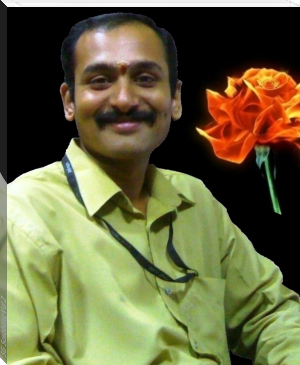SG Scribbling Vol 3, Sabari Ganesh [english love story books .TXT] 📗

- Author: Sabari Ganesh
Book online «SG Scribbling Vol 3, Sabari Ganesh [english love story books .TXT] 📗». Author Sabari Ganesh
A keen observation indicates that the act of competing with another fellow person is the result of lack of wisdom. Ganesh agreed to the competition with Kandan prior to the attainment of the fruit of wisdom. However; Upon receipt of which, Ganesh was happy to provide it to Kandan. Similarly, our ideas on competing with another fellow person and benefitting out of situations is an indication of lack of wisdom. The only way to eternal peace and contentment is the attainment of wisdom.
Analysing the success of Ganesh in securing the fruit of wisdom provides us another remarkable insight on the quality a person should imbibe. Ganesh and Kandan accepted that they lacked wisdom; hence the competition. In the competition to attain wisdom; Kandan tried to analyse the all pervading singular divinity in every form and name; hence roamed around the universe in search of the best without surrendering to any form. Ganesh in all humility blind-foldedly accepted the all pervading divinity in a singular form and surrendered unto it.
A sadhaka might learn from the Veda, Dharmasaastras, Puraanas and Upanishads that GOD is one and is the singular entity that permeates everywhere and that it transcends space and time. However, until the time of practical experience termed wisdom; it is an inevitable prerequisite for a sadhaka to stabilise one's mind on a single form and name; and surrender one's ego unto it, without any element of logic, reasoning and doubt. Perception of the all pervading divinity in every element of nature and effectively uniting with it is the result of wisdom. The personification of which is eternal peace transcending space and time.
The complete surrender of a sadhaka to a singular form and name of GOD without any element of logic, reasoning, doubt, or comparison is called Bhakthi. The intense devotion of the sadhaka across umpteen number of births; upon maturity condenses the all pervading singleton to a human form termed GURU. The union of the disciple in the GURU, due to complete surrender achieved upon maturity of devotion, is called Bhakthi Yoga. The resultant is wisdom; hence eternal peace.
Janmaanaekachathai: Sathaatharayuja Bhakthya Samaaraathitho
Bhakthaiyr Vaitheekalakshanaena Vithinaa Santhushta Eesa:swayam|
Saakshaath Shree Gururoopamaethya Krupaya Dhrukkochara: Sanprabhu:
Thathvam Saathu Vibhodhya Thaarayathi Thaan Samsaara Dhukkaarnavaath||
Sarva Vedanta Sidhaantha Saara Sangraham; 254
DeepavaliDeepavali
© Sabari Ganesh; “All Rights Reserved”
authorsabariganesh@gmail.com
https://sabariganesh23.sarahah.com
India is the land of multiple religions and innumerable traditions. Indians have always been tolerant to diversities. The sustenance of unity among people amidst practically evident differences revivifies the soul of India. The practical application of every religion is based on holy texts that contain the preaching of its leaders. However, in ancient India, the customary way of life evolved to be called Sanathana Dharma that we have termed now as a religion - Hinduism. In any other religion, one would be able to identify a person as to have created or formulated it, but Sanathana Dharma.
The substratum of every activity as determined by Sanathana Dharma is based on the Veda. The Veda is all pervasive, singular, unlimited and undivided. The significance of the Veda is in its being "Apaurusheyam"; meaning as not to have created by any person or entity. However, Sages with a higher degree of intellectual perception absorbed the Veda and provided it in a form that can be handled by normal human beings. It was Krishna Dwaibhayana aka Ved Vyasa who categorised the basic essentials of the Veda into four major streams - Rig, Yajur, Sama and Atharvana.
The resultant is the proliferation of Ashtaadasa Vidhya among human beings. The ancient mode of education comprised of imparting the Ashtaadasa Vidhya to eligible disciples adhering to the Brahmacharyaashramam. Hence the substratum of Hinduism comprises of the following eighteen texts -
Four Veda - Chathurveda - Rigveda, Yajurveda, Samaveda and Atharvanaveda; Four Upaveda - Ayurveda, Dhanurveda, Gandharvaveda and Arthasastra; Six vital segments - Shatangham - Shiksha, Vyaakarana, Kalpa, Nruktham, Jyothisham and Chandhas; Mimamsa, Nyaaya, Puraanas, Dharmasastras.Puraanas are a vital component of the Ashtaadasa Vidhya. There are umpteen number of Puraanas - Shiva Puraan, Vishnu Puraan, Skanda Puraan, Koorma Puraan, Matsya Puraan, etc.. of which; Bhagavad Gita is just a part of one Puraan. However, History evidence that much importance is being accorded to the Bhagavad Gita than any other.
There are many texts that are termed Gita - Ram Gita, Shiva Gita are a few to mention. However, the mere mentioning of the term Gita, is acknowledged to refer the Bhagavad Gita. Such is the importance and reverence accorded to the Bhagavad Gita though it was not popularised with any human or divine intention. The popularity of the Bhagavad Gita transcends the geographical boundaries of India - the motherland of Hinduism and is seen to have been existent in the islands of Java and Sumatra.
A prudent analysis would erode any element of ambiguity that such an importance accorded to the Bhagavad Gita can never be accidental. The essence of the Bhagavad Gita is the imparting of the eternal wisdom by Sree Krishna to Arjuna. There is no dearth of holy texts in Hinduism that imparts the eternal wisdom. As a matter of fact, it is the sole and essential focus of the ten Upanishads. Even Upanishads that posses a direct link to, and the ultimate peak of, the Veda are not revered as much as the Bhagavad Gita.
Generally, imparting wisdom on the inherent ephemerality of materialistic pursuits and the singularity of the Aathma, by a Guru to a disciple would be conducted at a location that is serene, peaceful and tranquil. The psychological states of the Guru and the disciple too shall be pleasant, conducive and relaxed. The Bhagavad Gita was discoursed by the Guru - Sree Krishna to the disciple - Arjuna in the battlefield. The war was between justice and injustice with tension prevailing around, building up muscle and strength with every passing second.
Uncertainty of life prevailed explicitly in the battlefield; in spite of which the Guru chose to impart the eternal wisdom to the disciple. It is sheer common sense to understand that at such a location - the war front, where remained no guarantee to life, Arjuna - the disciple surrendered unto Krishna to acquire the eternal wisdom; setting aside any kind of importance to any other element; even life. Hence the importance accorded to the Bhagavad Gita. The mere situational reference of Bhagavad Gita clarifies that eternal wisdom is precious than any element of materialistic pursuits of life; even life as it is! Hence the reason for the Bhagavad Gita to display unique divinity and consummate fame.
Another incident linked to the life of Sree Krishna has gained importance that matches up to the Bhagavad Gita. The slaying of Bhowman by Sathyabhama, spouse of Sree Krishna. Bhowman is the demon king who ruled the land named, "Praagjyothisham". It is the capital of Assam during his period. He was known for his notorious activities typical of a Raakshasaa. He had earlier obtained a boon that he should not be slain by any other but his mother.
Bhowman was born to Bhoodevi - Mother Earth and Lord Vishnu's incarnation - Lord Varaaha. Lord Varaaha after killing the demon King Hiranyaaksha rescued the Earth. Bhowman is born during that instance of the union between Lord Varaaha and Bhoodevi. However, since Lord Varaaha was drenched in the blood of the slain demon King Hiranyaaksha, Bhowman acquired the qualities of a Raakshasaa. Sathyabhama, spouse of Sree Krishna is an incarnation of Bhoodevi - the mother of Bhowman.
Sathyabhama realised that Bhowman who was slain by her was actually their own son. The son of Varaaha and Bhoodevi; reincarnated as Sree Krishna and Sathyabhama. Any lady could be affected by two major sorrows - the death of one's husband and the death of one's son. The former suffering has a miniscule tinge of selfishness as the lady shall henceforth be bereaved of all the auspicious respects. However, the sorrow experienced by a mother on the death of one's son is beyond comparison.
In spite of experiencing such a sorrow, Sathyabhama perceived the positive aspect of the incident - her son gaining the good fortune of receiving the presence and hence the blessings of the ultimate lord - Sree Krishna. The perception of the good by Sathyabhama, coupled with the realisation on the impermanency of the materialistic life, just like Arjuna; requested her lord, Sree Krishna that every human being in this planet that belongs to her - she being the incarnation of Bhoodevi aka Mother Earth; must celebrate the good merits and the resultant eternal wisdom gained by her son on this day; though his mortal journey would end.
We, humans are the children of mother Earth. Hence, her son Bhowman becomes our brother! On the day our brother is slain, our mother Bhoodevi perceived the positives of the situation - our brother gaining the blessings and vision of the lord. Sathyabhama aka Mother Earth that we have inhabited, was so very focused on the positives of the situation that made her request Lord Krishna that the good fortune acquired by her son, must be characterised by every human being gaining the blessings of Goddess Lakshmi and the benefit of bathing in the holy Ganga on this auspicious day, when they anoint their heads with oil and bathe in warm water; irrespective of the location.
"Thaile Lakshmi; Jhalae Ganga!"
In spite of the extreme sorrow of a mother - the death of her son; she perceived the good effects inherent in the mournful moment and absorbed the positives of the situation. Similarly, we humans too must develop the ability to perceive the positives in any given situation to remain optimistic and sanguine. He who derives pleasure out of other's suffering is a demon; one who allows others to suffer when he too is suffering is a lowlife; he who takes every effort to remove the obstacles and sufferings of others in spite of his own misfortune is divine.
The auspicious day when our brother Bhowman received the vision and blessings of the Lord Shree Krishna is celebrated across India as Deepavali. Bhowman is also called as Narakasura. The Bhagavad Gita actuates one to remain steadfast in acquiring the eternal wisdom with no consideration to materialistic life. The practical application of which is characterised by attempting the amelioration of every other living being despite one's own suffering; hence becoming divine - the stature of Sathyabhama and the essence of Deepavali.
The real celebration of Deepavali is not in bursting crackers, eating sweets and watching movies; but in taking every effort in our limited capacity to bring about a positive change in the lives of the suffering and the needy; termed Charity. Service executed in the good of humanity termed charity, is precisely the substratum and crux of every activity as decreed by Sanathana Dharma. Deepavali is the day of celebrating one's own yearlong efforts of charity.
Incidentally, Deepavali is celebrated on the day of Amavasya - the new moon day. As decreed by the Sanathana Dharma, Amavasya is the day when one offers food to deceased ancestors every month in a year





Comments (0)